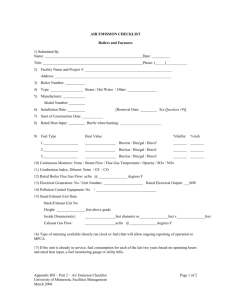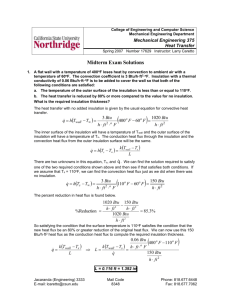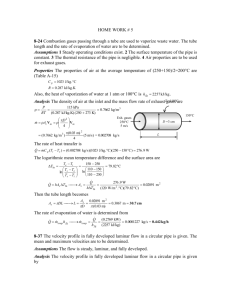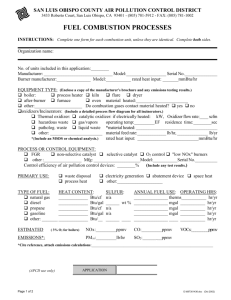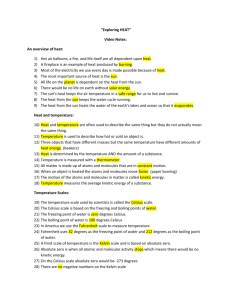Unit 9: April 16
advertisement
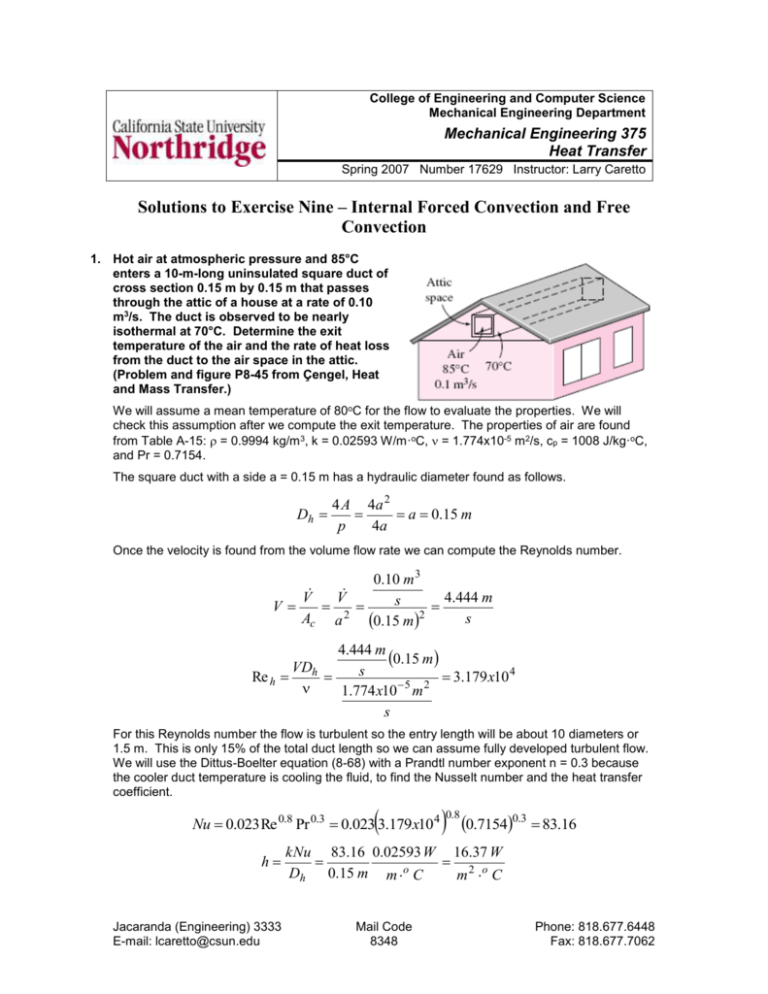
College of Engineering and Computer Science Mechanical Engineering Department Mechanical Engineering 375 Heat Transfer Spring 2007 Number 17629 Instructor: Larry Caretto Solutions to Exercise Nine – Internal Forced Convection and Free Convection 1. Hot air at atmospheric pressure and 85°C enters a 10-m-long uninsulated square duct of cross section 0.15 m by 0.15 m that passes through the attic of a house at a rate of 0.10 m3/s. The duct is observed to be nearly isothermal at 70°C. Determine the exit temperature of the air and the rate of heat loss from the duct to the air space in the attic. (Problem and figure P8-45 from Çengel, Heat and Mass Transfer.) We will assume a mean temperature of 80oC for the flow to evaluate the properties. We will check this assumption after we compute the exit temperature. The properties of air are found from Table A-15: = 0.9994 kg/m 3, k = 0.02593 W/m·oC, = 1.774x10-5 m2/s, cp = 1008 J/kg·oC, and Pr = 0.7154. The square duct with a side a = 0.15 m has a hydraulic diameter found as follows. Dh 4 A 4a 2 a 0.15 m p 4a Once the velocity is found from the volume flow rate we can compute the Reynolds number. 0.10 m 3 V V 4.444 m s V 2 2 Ac a s 0.15 m 4.444 m 0.15 m VDh s Re h 3.179 x10 4 5 2 1.774 x10 m s For this Reynolds number the flow is turbulent so the entry length will be about 10 diameters or 1.5 m. This is only 15% of the total duct length so we can assume fully developed turbulent flow. We will use the Dittus-Boelter equation (8-68) with a Prandtl number exponent n = 0.3 because the cooler duct temperature is cooling the fluid, to find the Nusselt number and the heat transfer coefficient. Nu 0.023 Re 0.8 Pr 0.3 0.023 3.179 x10 4 h Jacaranda (Engineering) 3333 E-mail: lcaretto@csun.edu 0.8 0.71540.3 83.16 kNu 83.16 0.02593 W 16.37 W 2 o Dh 0.15 m m o C m C Mail Code 8348 Phone: 818.677.6448 Fax: 818.677.7062 Exercise nine solutions ME 375, L. S. Caretto, Spring 2007 Page 2 We can compute the exit temperature of the air by the formula usual formula with NTU. We first compute the mass flow rate and the surface area for heat transfer (the four sides of the duct). 3 0.9994 kg 0.10 m 0.09994 kg m V s s m3 As 4aL 40.15 m10 m 6 m 2 6 m C 16.37 W NTU 2 hAs m 0.9750 m c p 0.09994 kg 1008 J W s s kg s 1 J 2 o Tout Ts Ts Tin e NTU 70o C 70o C 85o C e 0.9750 75.7oC The mean temperature between the inlet and the outlet is (85oC + 75.7oC)/2 = 80.35oC, which is close enough to our assumed mean temperature of 80oC so that we do not have to repeat the calculation. We can now find the heat transfer from the first law equation. 0.09994 kg 1008 J W s Q m c p Tout Tin 75.7 o C 85o C = –941 W s kg s 1 J 9-36E Consider an industrial furnace that resembles a 13-ft-long horizontal cylindrical enclosure 8 ft in diameter whose end surfaces are well insulated. The furnace burns natural gas at a rate of 48 therms/h. The combustion efficiency of the furnace is 82 percent (i.e., 18 percent of the chemical energy of the fuel is lost through the flue gases as a result of incomplete combustion and the flue gases leaving the furnace at high temperature). If the heat loss from the outer surfaces of the furnace by natural convection and radiation is not to exceed 1 percent of the heat generated inside, determine the highest allowable surface temperature of the furnace. Assume the air and wall surface temperature of the room to be 75oF, and take the emissivity of the outer surface of the furnace to be 0.85. If the cost of natural gas is $1.15/therm and the furnace operates 2800 h per year, determine the annual cost of this heat loss to the plant. (Problem and Figure P9-36E from Çengel, Heat and Mass Transfer.) We have an iterative solution because we do not know the surface temperature. If we assume that the surface temperature is 140oF we can find the properties for air at the mean temperature of (140oF + 75oF)/2 = 107.5oF from Table A-15E: k = 0.01546 Btu/hftoF, = 0.1852x10-3 ft2/s, and Pr = 0.7249. At the mean temperature of 107.5oR = 567.17 R, the expansion coefficient, = 1/T = 0.001763 R-1. Using the temperature difference of T = 140oF – 75oF = 65oF = 65 R and the characteristic length as the diameter D = 8 ft, we can find the Rayleigh number. Ra D gTD 3 2 2 32.174 ft 0.001763 s 3 0.7249 3.991x1010 Pr 65 R 8 ft 2 3 2 R s 0.1852 x10 ft Exercise nine solutions ME 375, L. S. Caretto, Spring 2007 Page 3 This value of RaL is in the correct range to use equation 9-25 in Çengel for the Nusselt number from which we can find the heat transfer coefficient. 2 2 1/ 6 10 1 / 6 0.387 Ra D 0.387 3.991x10 Nu 0.6 0.6 376.8 8 / 27 8 / 27 0.559 9 / 16 0.559 9 / 16 1 1 Pr 0.7249 h kNu 376.8 0.01546 Btu 0.7287 Btu L 8 ft h ft o F h ft 2 o F The surface area for heat transfer is the area of the cylindrical surface (assuming that the wellinsulated ends do not make a significant contribution to the heat transfer.) As DL 8 ft 13 ft 326.7 ft 2 The heat transfer through the walls will be 1% of the heat generated in the furnace. Since the furnace is 82% efficient and has a heat input of 48 therms/h, the heat generation within the furnace is (48 therms/h)(105 Btu/therm)(82%) = 3.936x106 Btu/h. Only 1% of this heat or 3.936x104 Btu/h will leave through the furnace walls by convection and radiation. The surface temperature can be found from the following equation for the combined modes of heat transfer. 3.936 x10 4 Btu Q h q hTs T Ts4 T4 2 As 326.7 ft 120.5 Btu 0.7287 Btu 0.1717 x10 8 Btu 4 Ts 534.67 R 0.85 Ts 534.67 R 4 2 2 2 4 h ft h ft R h ft R Using an iterative solution procedure such as the goal seek method of Excel gives the solution to this equation as Ts = 601.8 R = 141.8oR. We could repeat the entire calculation with this value of Ts to compute the properties and the Rayleigh number, instead of the value of 140 OF that we assumed. However, the differences will be negligible, and we conclude that the surface temperature the furnace is Ts = 141.8oC . Over a 2800 hour per year operating period there would be a heat loss of (3,935x104 Btu/h)(2800 h/yr) = 1.102x108 Btu/yr = 1.102x103 therms/yr. For natural gas that costs $1.15/therm, this heat loss is an annual cost of $1267/yr . 9-58E The figure at the right shows a 6in-wide and 8-in-high vertical hot surface in 78oF air that is to be cooled by a heat sink with equally spaced fins of rectangular profile. The fins are 0.08 in thick and 8 in long in the vertical direction and Exercise nine solutions ME 375, L. S. Caretto, Spring 2007 Page 4 have a height of 1.2 in from the base. Determine the optimum fin spacing and the rate of heat transfer by natural convection from the heat sink if the base temperature is 180 oF. (Problem and figure from Çengel, Heat and Mass Transfer.) We can find the properties for air at the mean temperature of (180oF + 78oF)/2 = 129oF from Table A-15E: k = 0.01597 Btu/hftoF, = 0.1975x10-3 ft2/s, and Pr = 0.7217. At the mean temperature of 129oF = 588.67 R, the expansion coefficient, = 1/T = 0.001699 R-1. Using the temperature difference of T = 180oF – 78oF = 102oF = 102 R and the characteristic length is the fin height, L = 8 in = 0.6667 ft, we can find the Rayleigh number. Ra gTD 3 2 2 32.174 ft 0.001699 s 3 0.7217 3.058 x10 7 Pr 102 R 0 . 6667 ft 2 3 2 R s 0.1975 x10 ft The optimum fin spacing, Sopt, is given by equation (9-32) in Çengel. S opt 2.714 L Ra 14 2.714 0.6667 ft 3.058 x10 7 0.02433 ft = 0.292 in When the optimum fin spacing is used, equation (9-33) in Çengel tells us that the Nusselt number based on the fin spacing is a constant equal to 1.307. This gives the heat transfer coefficient. h kNu 1.307 0.01597 Btu 0.7287 Btu S opt 0.02433 ft h ft o F h ft 2 o F The number of fins, n, is found from the fin thickness and the fin spacing compared to the total width. n 6 in 16 fins 0.292 in 0.08 in fin fin Each of these fins has two side areas of 1.2 in by 18 in plus an outer edge that is 0.08 in thick and has a total length on three sides of 1.2 in + 1.2 in + 8 in = 10.4 in. This gives the total fin area. As 1628 in 1.2 in 10.4 in 0.08 in 320.5 in 2 2.226 ft 2 The convective heat transfer is given by the usual equation 0.8578 Btu Q hAs Ts T 2.227 ft 2 180o F 78o F 196 Btu/h 2 o h ft F


